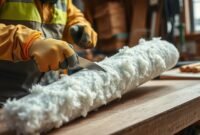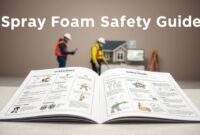Insulation material, a crucial component in home insulation, is a key consideration for housebuilders. They aim to select types of insulation that provide thermal protection and have minimal long-term adverse effects.
Among these, cellulose insulation, known for its energy efficiency and use of recycled material, is emerging as a popular ‘green’ choice.
Cellulose insulation offers an efficient, cost-effective, non-toxic, and green thermal solution that should be considered.
For you who wondered what cellulose insulation is made of, here we will discuss thoroughly how to make cellulose insulation, what is used in making cellulose insulation, what is its resistance to fire, and things to consider when choosing cellulose insulation as your material of use.
What is Cellulose Insulation Made Out of
Cellulose insulation, a sustainable option for home insulation, is composed of recycled paper, primarily old newspapers or recycled jeans.
This cellulose fiber is enhanced with about 15% fire-retardant additives like ammonium sulfate, borax, or boric acid, contributing to its energy efficiency and safety.
According to the Cellulose Insulation Manufacturers Association (CIMA), cellulose insulation used in a 1500 ft2 house recycles as much newspaper as a person collects in 40 years.
In a year, 3.2 million old newspaper waste will be more helpful if every new house built uses cellulose insulation. Furthermore, cellulose insulation uses less energy to manufacture than fiberglass, so it is classified as a ‘green’ material.
Read also: How Long Does Attic Insulation Last?

How to Make Cellulose Insulation
After understanding what cellulose insulation is made of, you might want to create a DIY version. To make cellulose insulation, a form of loose-fill insulation, you’ll need a respirator, old newspapers, a hammermill, borax, aluminum sulfate, and lime.
This process involves shredding the paper into fine particles, suitable for installation with a blowing machine. Before making, use a respirator to protect you from dust or other particles that could harm your respiratory system.
The first step is to shred the paper until it has a very fine texture or until you can no longer read any words from it. Make sure the paper is completely dry. The next step is to mix the paper with borax to make the cellulose insulation fire-resistant.
Add 50/50 aluminum sulfate and lime mixture. Drop all the material in the hammermill while shredding the paper to mix the compound evenly.
Is Cellulose Insulation Flammable?
Even though cellulose insulation contains borax, which can be a fire retardant component, it is still flammable because it is made of paper. The borax could keep the fire from spreading too quickly.
Read also: Is Spray Foam Insulation Flammable?
Disadvantages of Cellulose Insulation
If you are considering installing cellulose insulation in your house, consider the downside of this type of material.
- Because it is paper-constructed, cellulose insulation produces more dust than any other material.
- Installing cellulose insulation can be more expensive than installing fiberglass insulation.
- When you utilize cellulose insulation, mold and rot are likely to occur.
Cellulose insulation, available in different forms like densely packed cellulose for wall cavities and loose-fill cellulose for attics, offers versatility. However, when considering loose-fill cellulose, it’s important to have the right blowing machine for effective installation.
The dense pack cellulose method ensures a snug fit in wall cavities, enhancing thermal performance and reducing energy costs. On the other hand, loose-fill cellulose is easier to install in irregular spaces, making it a flexible choice for many homeowners.
Effective Application and Versatility of Cellulose Insulation
Finding the right spray foam for your insulation needs is crucial. While cellulose insulation is a sustainable and green option, it’s important to consider its application method.
A blowing machine is typically used to distribute the insulation evenly for loose-fill cellulose, ensuring effective coverage and optimal thermal performance. This method is particularly useful in attics, filling irregular spaces and providing excellent insulation.
The answer to the question ‘What is cellulose insulation made of?’ is revealed. Hopefully, it has broadened your insight into how to choose the best insulation material for your house.


